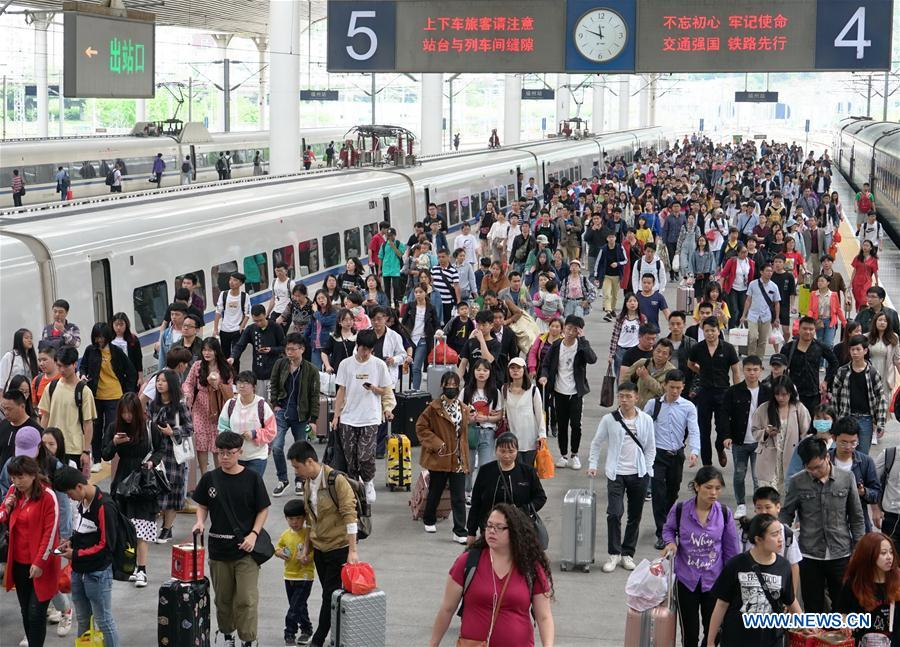
May 1st marks the International Workers' Day. /VCG
May 1st marks the International Workers' Day. /VCG
Editor's note: Matteo Giovannini is a finance professional at the Industrial and Commercial Bank of China in Beijing and a member of the China Task Force at the Italian Ministry of Economic Development. The article reflects the author's opinions and not necessarily the views of CGTN.
The history of International Labor Day in China dates back to the 1920s when in Beijing and Shanghai were held demonstrations in honor of all workers. The holiday was then officially established and approved by the Chinese government in 1949, and today represents an opportunity for families to travel and attend events with many attractions across the country with discount prices.
This year's International Labor Day, assumes even a greater significance for China as a consequence of the outbreak of coronavirus that has affected the country since January forcing a whole nation to stay at home and locking people within their own cities.
In addition, the strategic collocation of this holiday, between the Spring Festival and the National Holiday, assumes importance even from an economic perspective and it is going to be carefully observed by stakeholders to understand the appetite for travel of Chinese tourists, at a time when most of the restrictions have been eased, in order to understand the recovery path of the world's second economy.
Signals of recovery in the Chinese economy from COVID-19 have been emerging through the so-called "revenge spending," the result of a long-time forced lockdown combined with the amount of cash saved by households in the last three months, leading people to an impulsive spending spree targeting luxury brands and making companies, such as Hermes, register record sales in a single day.
Another phenomenon called "revenge travelling" is expected to follow considering the booming Chinese tourism before the COVID-19 crisis and the high number of cancelled trips that followed the outbreak of coronavirus. The desire of Chinese to get out from their cities after such a long time of lockdown and to visit other locations represent a message of confidence in the effort of the country to fight COVID-19 and at the same time it can provide a lifeline for the tourism industry that has been severely affected by the outbreak.
The Labor Day holiday, takes place in the first five days of May, represents the first peak for China's tourism industry, and data from Ctrip, China's largest online travel operator, show that more than 80 million Chinese are expected to go on their first vacation after the lockdown with a number of travelers that will be two times more than during the Qingming tomb-sweeping festival earlier April.
The outbreak of coronavirus is certainly having an important impact in terms of the different approaches Chinese people have towards travel booking starting from the choice of destination. While in the past China's major online travel agencies registered bookings up to 60 percent towards destinations to neighbor countries such as Japan, Indonesia, and Thailand and with a growing interest for countries along the Belt and Road; this year, the total number of bookings are related to domestic destinations.

Passengers arrive at Fuzhou railway station in southeast China's Fujian Province, May 4, 2019. /Xinhua
Passengers arrive at Fuzhou railway station in southeast China's Fujian Province, May 4, 2019. /Xinhua
The concern about safety is another important factor that has been affecting people's consumption this year forcing families to increase the demand for quality vacation. Ctrip shows a large majority of online reservations towards four and five stars hotels, car rental and prioritizing hygiene and social distancing.
This trend shows that Chinese families are willing to pay a premium price to guarantee clean and sanitized accommodations and a bit of privacy by avoiding overcrowded destinations where the risk of contagion is still present.
China's cultural tourism industry has been greatly affected, but signs of recovery are present and according to TravelDaily, 65 percent of the surveyed think that China's tourism will be able to rebound within three to six months from now with a small peak in July-August and into a steady growth until Q4; but predictions remain tightly bonded to the speed of recovery of other countries in containing COVID-19 by guaranteeing safety and lifting travel restrictions.
Asian countries are expected to recover faster due to successful measures to contain COVID-19 and due to the preference of Chinese people to initially reach closer destinations avoiding long flights that cannot guarantee proper social distancing. In this sense, Japan, Thailand, Singapore, South Korea, and Malaysia are expected to benefit and welcome the first wave of Chinese travelers.
For the rest of the world, it is projected that a rebound in tourism will happen later this year, maybe in correspondence with the National holiday in October, but the opportunity to return to travel to international destinations, such as Europe, will depend on the ability and the efficiency of governments to contain the virus and limiting travels on planes and trains at half capacity to guarantee safety through social distancing.
China remains in the spotlight and Labor Day can represent a pilot test for the path to recovery of the Chinese tourism industry. Meanwhile, it can send a message of hope to other countries whose accommodation, entertainment, F&B and transportation services are desperately missing the lucrative inbound of Chinese tourism.
(If you want to contribute and have specific expertise, please contact us at opinions@cgtn.com.)